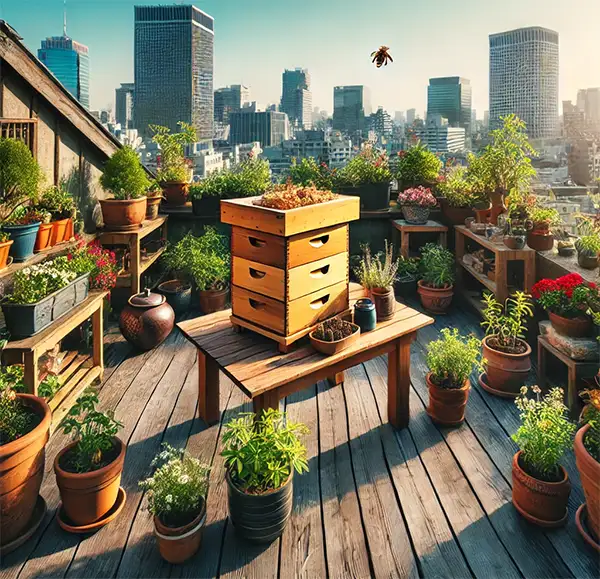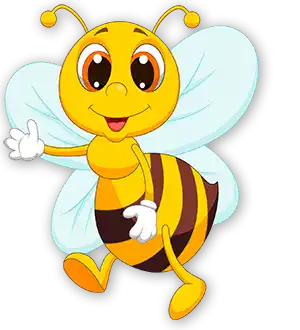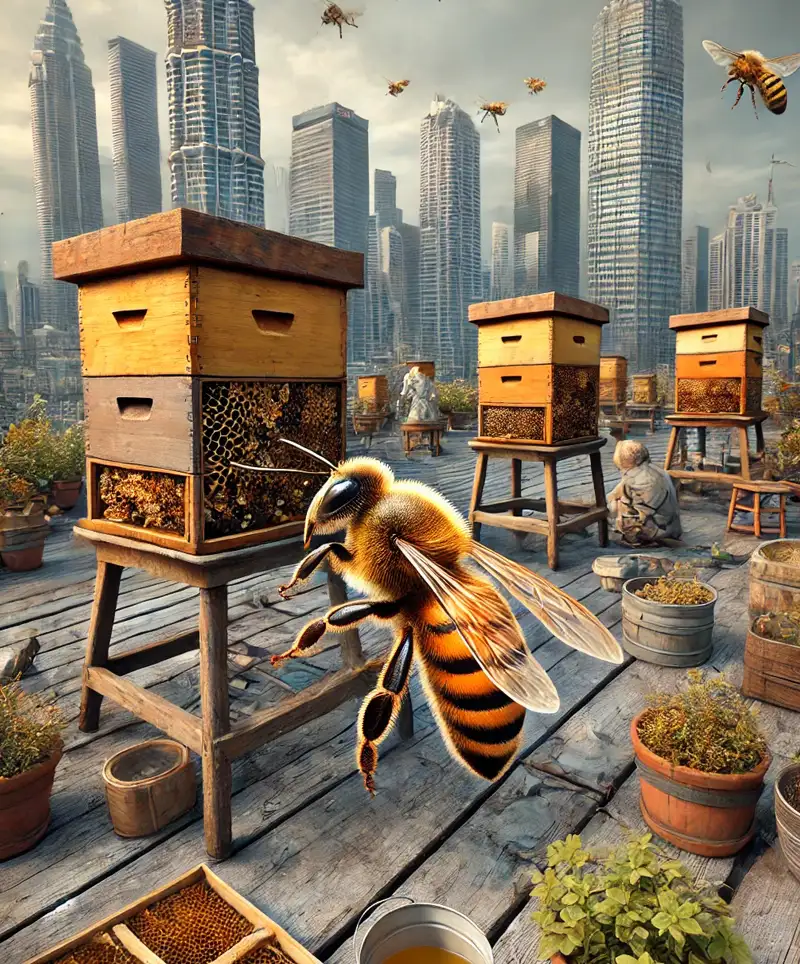The Urban Bee’s New Buzzing Address
City living may have its perks—fast WiFi, endless coffee shops, and food delivery to your door at 2 a.m.—but the urban landscape is now home to something a little more...buzzy. Yes, amidst the bustling streets and neon lights, bees are joining the ranks of the city’s most dedicated residents. On National Urban Beekeeping Day, we pay homage to these winged city-dwellers, and their keepers, for transforming rooftops and tiny backyards into miniature honey factories.
Imagine bees zipping through the skyscraper canyons of New York or London like little insect commuters, navigating their way to the nearest nectar source as if it were the corner bodega. Urban bees have adapted to the city’s patchwork of green spaces, sipping nectar from balcony planters, rooftop gardens, and even the occasional flowering weed poking through a sidewalk crack. They’re living proof that bees don’t need rolling meadows to thrive—they just need a few floral options and a bit of imagination. Turns out, city bees are as resourceful as the humans they share the sidewalks with.
The Tantalizing Taste of City Honey
City honey isn’t your ordinary, store-bought squeeze-bottle honey; it’s an experience. Each jar is infused with hints of whatever plants the bees could find. Think about it: a spoonful of urban honey might have subtle notes of rosemary from that rooftop herb garden down the block or traces of honeysuckle from a nearby city park. It’s like tasting the city itself—minus the smog, of course. So when you drizzle a bit of urban honey on your toast, remember that you’re getting a unique flavor profile that’s as vibrant as the city streets outside.
 And there’s nothing quite like impressing your friends with a taste of “locally-sourced honey” from, say, your own window box. You might not have sprawling fields of clover, but a bit of thyme from the rooftop planter or lavender from the community garden will do the trick. In a city that prides itself on craft cocktails and artisanal pickles, nothing screams “urban chic” quite like your own brand of city honey.
And there’s nothing quite like impressing your friends with a taste of “locally-sourced honey” from, say, your own window box. You might not have sprawling fields of clover, but a bit of thyme from the rooftop planter or lavender from the community garden will do the trick. In a city that prides itself on craft cocktails and artisanal pickles, nothing screams “urban chic” quite like your own brand of city honey.
A Day in the Life of an Urban Beekeeper
The urban beekeeper is a bit of a modern hero. While they may look like they’re suited up for a sci-fi convention, these folks are armed with bee suits, hive tools, and a seemingly endless supply of enthusiasm. Managing a hive in the city comes with unique challenges: curious neighbors who wonder why there’s suddenly a “buzz” around the building, the occasional complaint about bee parking violations, and the ever-present risk of a wayward bee straying into someone’s cold brew.
Yet, despite it all, urban beekeepers are committed. They scout for safe hive spots, research bee-friendly plants, and keep an eye on city regulations (because apparently, not everyone appreciates a hive on their high-rise balcony). And while balancing the demands of city life with beekeeping may seem tricky, urban beekeepers are nothing if not creative. From attending bee meet-ups (yes, they exist) to swapping stories of bee shenanigans, they’re building a network of pollinator advocates—one rooftop at a time.
City Bees and Pollinator Powerhouses
Bees in the city aren’t just working overtime for our honey cravings—they’re environmental ambassadors. Schools and community programs are buzzing with beekeeping classes, where kids (and adults) learn that bees aren’t just “those things that sting.” These programs demystify the little pollinators, giving city folk a chance to witness the marvels of bee life up close. After all, not many kids grow up thinking, “I want to be a beekeeper,” but once they meet these fuzzy heroes, a future generation of urban beekeepers might just be born.
And these tiny aviators are practically celebrities in their neighborhoods. They pollinate community gardens, green up neglected city lots, and make city parks bloom in a way that defies the urban gray. So the next time you’re admiring a particularly lush city park, tip your hat (or maybe your flower) to the bees who keep it buzzing.
City Beekeeping: Not for the Faint of Heart
Starting an urban hive may sound straightforward, but it takes more than just plopping a box on your balcony. Urban beekeepers have to think about everything, from ensuring bees have enough plants nearby to providing a water source (because even city bees need to hydrate). A dish with pebbles, a few water drops, and—voila!—you’ve got yourself a bee watering hole.
Then there’s the inevitable moment when the beekeeper has to defend their choice of hobby to bewildered neighbors: “Yes, these bees are safe. No, they’re not going to dive-bomb your iced coffee.” And while neighbors may grumble at first, a jar of honey tends to smooth things over.
And that’s not to mention the regulatory hoops urban beekeepers must jump through. Many cities have strict guidelines for hive placement, which leads to beekeepers getting creative. Whether it’s a concealed rooftop nook or a backyard corner disguised with foliage, these hive spots are as prized as Manhattan real estate. But the sight of bees happily buzzing in their concrete oasis, combined with that first spoonful of hyper-local honey, makes all the paperwork and odd looks worthwhile.
 A Swarm of Sweet Changes
A Swarm of Sweet Changes
As we celebrate National Urban Beekeeping Day, take a moment to appreciate the industrious bees and the equally industrious humans who care for them. These tiny pollinators are transforming our cities, one hive at a time, filling green spaces, pollinating gardens, and reminding us all of our connection to nature—even in the busiest metropolis. In a world that often feels disconnected from the natural world, urban beekeepers are bridging that gap, creating something sweet and sustaining right in our backyards.
So the next time you’re strolling through a city park or admiring a rooftop garden, keep an eye out for the tiny workers helping it all bloom. And if you’re lucky enough to meet an urban beekeeper, ask them about their hive—they might even share a taste of their local honey. Because in the grand landscape of city life, there’s nothing quite as delightful as knowing that bees are right there, keeping the city just a little sweeter and a lot more alive. Happy National Urban Beekeeping Day!
Please Share our Content






 And there’s nothing quite like impressing your friends with a taste of “locally-sourced honey” from, say, your own window box. You might not have sprawling fields of clover, but a bit of thyme from the rooftop planter or lavender from the community garden will do the trick. In a city that prides itself on craft cocktails and artisanal pickles, nothing screams “urban chic” quite like your own brand of city honey.
And there’s nothing quite like impressing your friends with a taste of “locally-sourced honey” from, say, your own window box. You might not have sprawling fields of clover, but a bit of thyme from the rooftop planter or lavender from the community garden will do the trick. In a city that prides itself on craft cocktails and artisanal pickles, nothing screams “urban chic” quite like your own brand of city honey. A Swarm of Sweet Changes
A Swarm of Sweet Changes








 "Sláinte!" is a traditional Irish expression used as a toast, equivalent to "Cheers!" in English.
"Sláinte!" is a traditional Irish expression used as a toast, equivalent to "Cheers!" in English.